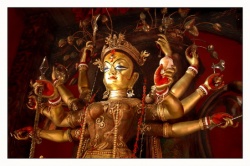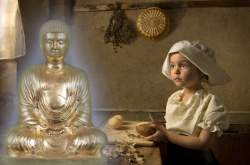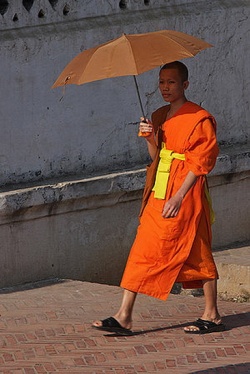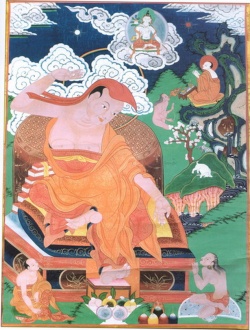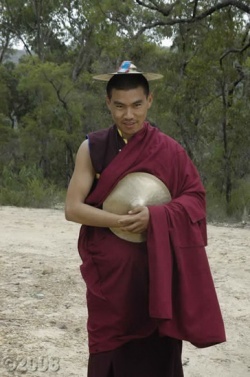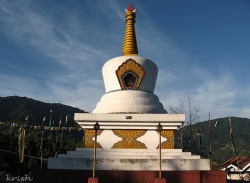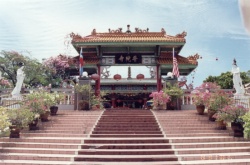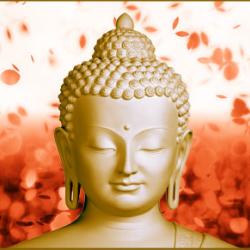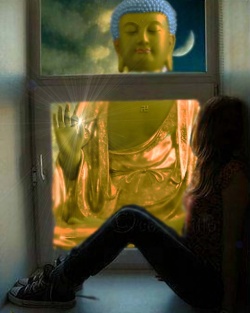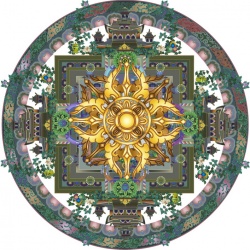Sakya tradition
The History of Sakya begins with a race of celestial beings having descended from the Clear Light heavens in the Realm of Form to take up residence in the snow mountains of Tibet for the benefit of living beings. This was ten generations before the arrival of Guru Padmasambhava.
At this time they were known as Lha Rig. After eight generations, due to a dispute with a Yaksha leader, the Lha Rig also became known as the Khon which means 'dispute' or 'strife.' In 750 A.D. the Khon family became students of Guru Rinpoche Padmasambhava receiving especially the Vajrakila empowerment.
A Khon son received novice monk ordination from Shantirakshita at Samye, becoming one of the first seven monk translators in all of Tibet. For the next thirteen generations (750-1073), the Khon family was a central pillar of the Nyingmapa School in Tsang Province.
In the eleventh century, due to the obscurations of beings, Dharma practice became very lax in Tsang. It was decided by the head of the family, Sherab Tsultrim, that it was time to seek out the new Tantras from India. Guru Padmasambhava wrote; "an emanation of the Indian Virupa - Drogmi Lotsawa will appear."
The younger brother, Konchog Gyalpo, went to study with Drogmi Lotsawa (992-1074). At an auspicious location, below a white patch of earth (Tib.: sa skya), prophesied by Guru Padmasambhava and Lord Atisha, Khon Konchog Gyalpo built the first temple named the Gorum Zimchi Karpo in 1073. This marks the beginning of the name "Sakya."
The holy family, the hereditary leaders of this precious lineage, are known by these three names, Lha Rig, Khon and Sakya."
Sachen Kunga Nyingpo (1092-1158), the son of Khon Konchog Gyalpo, was a person of extraordinary skill and spiritual attainment, holding all the lineages of Sutra and Tantra. His main teachers were first his father from whom he received mainly the Vajrakila and Samputa Systems of practice.
From Bari Lotsawa he recieved namely Chakrasamvara, Guhyasamaja, Vajrabhairava and others; from Shangton Chobar, the entire Lamdre system over a period of four years along with the systems of Mahamaya and Samayogadakinijala.
From Mal Lotsawa Lodro Drag he recieved the Chakrasamvara, Bhairava, the teachings of mahasiddha Naropa namely the Vajrayogini, and of significant importance the lineages of Panjarnata Mahakala. From Lama Nam Kaupa he received all the instructions, outer, inner and secret of the Four-faced Protector Chaturmukha. These were only the main teachers of Sachen Kunga Nyingpo.
At the age of twelve while in a six month Manjushri retreat he had a vision of Manjushri accompanied by two bodhisattvas who spoke to him with the lines of the Separation From The Four Attachments;
"With attachment to this life - there is no Dharma student;
Attachment to the Three Realms - no renunciation;
Attachment to self-purpose - no Enlightenment Thought;
If grasping arises - there is no view."Sonam Tsemo
Sachen Kunga Nyingpo received the Lamdre teaching first from Shangton Chobar and secondly directly from Virupa in a series of visions that lasted a month. This is known as the 'recent' or 'close' Lamdre lineage.
Sachen had four sons - Kunga Bar, Sonam Tsemo, Jetsun Dragpa Gyaltsen and Palchen Rinpoche. The first died while studying at Nalanda in India.
he second son Sonam Tsemo (1142-82) became a learned scholar at the early age of sixteen. At the age of forty-one he ascended bodily to Khechara, the divine realm of Vajrayogini.
He had visions of many meditational deities and also produced many realised disciples. Jetsun Dragpa Gyaltsen (1147-1216) received lay celibacy vows and showed strong signs of spiritual maturity in his youth. At the age of eleven he gave his first Hevajra teaching.
The main student of Jetsun Dragpa Gyaltsen was his nephew, son of Palchen of Opoche the famous Sakya Pandita Kunga Gyaltsen (1182-1251). Studying Buddhist and non-Buddhist philosophy, tantra, logic, Sanskrit, poetry, astrology and art with countless Indian, Nepalese, Kashmiri and Tibetan masters, he achieved mastery over all these subjects.
When twenty-seven years old, after meeting with the Kashmiri Pandita Shakya Shribhadra, he became a fully ordained monk and maintained his vows without the least infraction. His works such as the Treasury of Logic on Valid Cognition (Tsad-ma rigs-gter) and the Discrimination of the Three Vows (sDom-gsum rab-dbye) are famous to this day. In all he wrote 114 religious treatises.
The Treasury of Logic on Valid Cognition (Tsad-ma rigs-gter) was the only text of Tibetan origin ever to have been translated into the Sanskrit language. The translation was rendered by his Indian students at Nalanda University in Magadha, and was received with much acclaim. "At the time of his mahaparinirvana, the earth shook six times and birds throughout the kingdom cried in lament.
Wondrous signs were seen by the assembly of disciples and kings when the pyre was lit, and all who were present experienced blissful peace. Having attained perfect enlightenment by the grace of Manjunatha, he is known to the world as the Buddha Vimalashri."
In 1244, Godan Khan, grandson of Chingis Khan, intrigued by Sakya Pandita's reputation, invited him to Mongolia to give Sakya PanditaBuddhist teachings. Later, in 1253, after both Sakya Pandita and Godan Khan had passed away, the emperor, Sechen Kublai Khan invited Drogon Chogyal Pagpa.
nephew of Sakya Pandita to his court. Pagpa invented a new script for the purpose of writing the Mongolian language.
Kublai Khan was so impressed by Pagpa's performance that he declared Buddhism the state religion of Mongolia and presented him the rulership of the three provinces of Tibet. Thus, Pagpa was the first person in Tibetan history to gain religious and secular authority over the entire country.
It was at this time that the great temple Lhakang Chenmo was constructed at Sakya. To this day it still stands and houses the greatest religious library in Tibet, statues and religious objects of antiquity. Pagpa was succeeded by his brother Chagna and altogether the Sakyapas ruled Tibet for more than a hundred years.
Eventually, Tishri Kunglo (1299-1327), eldest of the fifteen grandsons of Sakya Pandita's brother, founded four dynastic Palaces (Podrang): Zhithog, Rinchen Gang, Lhakhang and Ducho of which only the last survives. In the eighteenth century at the time of Sakya Trizin Wangdu Nyingpo, the second Padmasambhava of this age, the Ducho Palace split into two - the Drolma Podrang and Phuntsok Podrang.
The present heads of these two palaces are Khyabgon Holiness Sakya Trizin Ngawang Kunga (b. 1945) of the Drolma Palace, the current head of the Sakya tradition, the 4lst holder of the Sakya Throne and living in Dehra Dun, India. He has two sons, Ratna Vajra and Gyana Vajra.
He also has a sister, [[Jetsunma]Chimey Luding]], that teaches extensively throughout the world. Gongma Dagchen Rinpoche (b. 1929) of the Phuntsok Palace founded Sakya Thegchen Choling in Seattle, Wash. U.S.A. He had one brother, Gongma Thinley Rinpoche, a monk who past away recently. Dagchen Rinpoche also has five sons.
The second son, Ananda Vajra Rinpoche, an accomplished lawyer, has assisted the Dalai Lama and the Tibetan refuge governmnet with legal and constitutional matters. Succession to the position of Sakya Trizin, head of the Sakya tradition, has been hereditary since the time of Khon Konchok Gyalpo and recently - alternates between the two palaces.
Amongst the principal holders of the Sakya tradition, Sachen Kunga Nyingpo, Sonam Tsemo, Dragpa Gyaltsen, Sakya Pandita Kunga Gyaltsen and Drogon Chogyal Pagpa are known as the Five Superiors of the Sakya tradition, the Jetsun Gongma Nga. The first three are known as the 'Three White Ones' and the last two as the 'Two Red Ones.'
After these there were the Six Ornaments of Tibet: Yagton Sanggye Pal and Rongton Mawe Sengge, who were famous for their knowledge of sutra teachings; Ngorchen Kunga Zangpo and Dzongpa Kunga Namgyal - learned in the tantras; Gorampa Sonam Sengge and Shakya Chogden - learned in both sutras and tantras. These are the most important masters of the Sakya tradition.
Amongst them, Gorampa Sonam Sengge instituted the formal study of logic.
Like other traditions of Tibetan Buddhism, a number of branch lineages emerged. The lineages which strictly hold to the teachings of Sakya Pandita Kunga Gyaltsen are Sakya, Ngor and Tsar. Ngorchen Kunga Zangpo (1382-1457) and successive masters such as Konchok Lhundrup, Thartse Namkha Chime Palzang and Drubkhang Palden Dhondup founded the Ngor lineage.
Tsarchen Losal Gyatso (1502-56), followed by Jamyang Khyentse Wangchuk and Mangto Ludrup Gyatso founded the Tsar lineage.
Three other traditions rooted in the Sakya lineage are the Bulug/Shalu founded by Buton Rinchen Drub, the Jonang founded by Dolpopa Sherab Gyaltsen and followed by Jonang Taranata and the Bodong founded by Bodong Panchen Chogle Namgyal. The Dzongpa of Dzongpa Kunga Namgyal has also been treated as a separate lineage.
"But among all these [[[Sakya]]] traditions, there are only a few minor differences which appear in their explanations and theories of Sutra and Tantra," - Dzongsar Jamyang Khyentse Chokyi Lodro. Concerning the view, in Tibet, three interpretations of Madyamika have arisen;
Nihilistic Madyamika, Eternalistic Madyamika (shan tong) and Middle Way Madyamika. The Sakyapa follow the Middle Way Madyamika as taught by Sakya Pandita and ellucidated by Gorampa Sonam Sengge and others.
Within Sakya, of the hundreds of Indian Buddhist teachings assimilated into the religious life of Tibet through the efforts of the Five Founding Teachers the most famous were the Hevajra transmission originating with Virupa,
the Vajrakila of Padmasambhava,
the Vajrayogini of Naropa,
the Mahakala of Vararuchi and
the Guhyasamaja of Nagarjuna.
These five Indian Mahasiddhas are considered the most renowned in Sakya.
Aside from these preeminent lineages there is the group of Four Tantras;
Hevajra, Chakrasamvara, Guhyasamaja and Vajrabhairava.
Another important set is the Thirteen Golden Dharmas comprised of the Three Red Ones, the Three Great Red Ones, the Three Lesser Red Ones, Black Manjushri, Avalokiteshvara Simhanada, Sabala Garuda and Red Jambhala.
There are several different versions of enumerating the thirteen, however the three sets of Three Red Ones have remained consistent. These are only the main Anuttarayoga tantric practices of Sakya, there are hundreds of other lineages of teachings such as Hayagriva, Kalachakra, Mahamaya, Manjushri, Vajrapani, Tara and the like.
In the Sakya monastic colleges eighteen major texts are thoroughly studied. Currently there are only a few colleges, the main one in Rajpur India and a second at Boudhanath in Kathmandu Nepal. A few still remain open in Tibet such as Dzongsar Khamje Ling.
The eighteen texts teach
the Perfection of Wisdom,
Monastic Discipline (vinaya),
Madyamaka View, Phenomenology,
Logic and
Epistemology.
Commentaries unique to the tradition are the Discrimination of the Three Vows and the Treasury of Logic on Valid Cognition by Sakya Pandita. Also, the works of Gorampa Sonam Sengge are especially important, amongst others.
On graduation, a monk is granted the degree of Kazhipa, Kachupa and Rabjampa on the basis of merit.
The major Sakya monasteries in Central Tibet are Lhakhang Chenmo founded by Khon Konchog Gyalpo (the main Sakya Lhakhang Chenmo monastery),
Ngor Ewam Choden founded by Ewam Kunga Zangpo (the main Ngorpa monastery),
Dar Drangmoche in Tsang founded by Tsarchen Losal Gyatso (the main Tsarpa monastery),
Nalanda in Phenpo built by Rongton Sheja Kunrig and
Tsedong Sisum Namgyal established by Namkha Tashi Gyaltsen.
In Kham provence, Dhondup Ling was founded by Dagchen Sherab Gyaltsen,
Lhundrup Teng of Dege founded by Tangtong Gyalpo, as well as
Dzongsar monastery the home of Jamyang Khyentse Wangpo and
Chokyi Lodro;
and Deur Chode built by Chodak Sangpo in Amdo.
In all, there were several thousand Sakya Monasteries spreading from China and Mongolia to Western Tibet, Kashmir, Nepal and India.
Presently, Tsechen Tenpai Gatsal in Rajpur, U.P. and Sa Magon in Puruwalla, H.P. are the two main Sakya Monasteries. Ngor Ewam Choden in Maduwalla, Dehradun is the main Ngorpa monastery. Tashi Rabten Ling at Lumbini, along with two other monasteries in Kathmandu, Nepal represent the Tsarpa lineage.
At present, Sakya Trizin Ngawang Kunga is the head of the Sakya School and second in Tibetan religious protocol only to H.H. the Dalai Lama. Luding Khen Rinpoche is the Head of the Ngor School and Chogye Trichen Rinpoche is head of the Tsar School.
Text Jeff Watt
see also:Sakya
